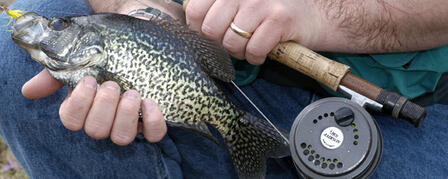SHALLOW WATER CRAPPIE EVERYMAN’S GAME

Spring spawn draws crappie into wading water
PRATT — One of the most anticipated angling opportunities in Kansas is the spring crappie spawning period, usually from late April through May. The cool spring of 2011 may have delayed this year’s run, but warmer weather is in the forecast, and crappie are on the move. Reports from many reservoirs have crappie staging in water 15 to 20 feet deep, but once the water warms, anglers can expect to catch crappie as they move close to shore, where they spawn near brush piles and rocky shoreline along dams. This concentrates the fish and makes great fishing for boaters and shore anglers.
Crappie move to shallow areas when water temperatures reach the mid-50s and wait to spawn at water temperatures of 60-65 degrees. Depending on water clarity, they may spawn as shallow as 2 feet deep and are most active at dawn and dusk, when light levels are low. While brush and rocky shorelines are ideal, any visible structure may harbor spawning crappie.
Live minnows are good crappie bait, especially during cool spells when fish are less active. Hook the minnow just under the dorsal fin to keep it lively. Use a bobber to set depth, and keep a minnow near structure where the fish are hiding. When crappie are most active, small, colorful jigs can be even more productive. Small spoons, spinners, or crankbaits are effective, as well. For the avid fly fisherman, crappie present a welcome challenge and bite well on a variety of streamer flies.
Most crappie anglers use ultralight spinning gear because the fish generally weigh a pound or less. Monofilament line of 4- to 6-pound test allows an angler to cast tiny jigs and provides better feel for light bites. A slip bobber or float can help keep a small jig at just the right depth and avoid snags.
Spawning crappie are easily frightened by noise, so approach shallow fishing spots quietly. Some anglers use 8- to 10-foot rods, wading and dipping a jig in a technique known as "doodlesocking." Dipping the jig in likely-looking habitat, the doodlesocker can fish from spot to spot without spooking the fish. This is an effective method when crappie are in water about 3 feet deep or less.
Most anglers consider crappie among the best aquatic table fare, and for those looking for a great meal, it doesn't get any better than spring crappie fishing. This year, the top-rated crappie reservoirs include Hillsdale, Perry, Clinton, Melvern, Kirwin, Lovewell, and Marion. The best small lakes include Wellington Hargis Creek Lake, Yates Center South Owl Lake, Lake Shawnee, Neosho State Fishing Lake, Ottawa State Fishing Lake, and Polk Daniels Lake in Howard.
Other lakes and reservoirs may offer excellent crappie fishing, as well. For more information on crappie fishing prospects, go to the Kansas Department of Wildlife and Park's (KDWP) website, www.kdwp.state.ks.us. Reservoir ratings for both black and white crappie may be found in the KDWP Fishing Forecast. In addition, the most currently-recorded biologists' fishing reports may be found on the agency's Fishing Reports web page, and anglers can report their own experiences and read those of others on the department's Public Fishing Reports page. Water temperatures typically vary from north to south in Kansas, so some movement may begin later in the state's northernmost lakes.
Because they are prolific in most Kansas waters, crappie creel limits are liberal — in most places, 50 fish per day. Some lakes have more restrictive length and creel limits. Check the 2011 Kansas Fishing Regulations Summary, available wherever licenses are sold, or the KDWP website for details. Fishing conditions may vary depending on weather, particularly storms and heavy run-off. For up-to-date information on lake conditions, go to "Where To Fish In Kansas" on the KDWP website.
-30-







